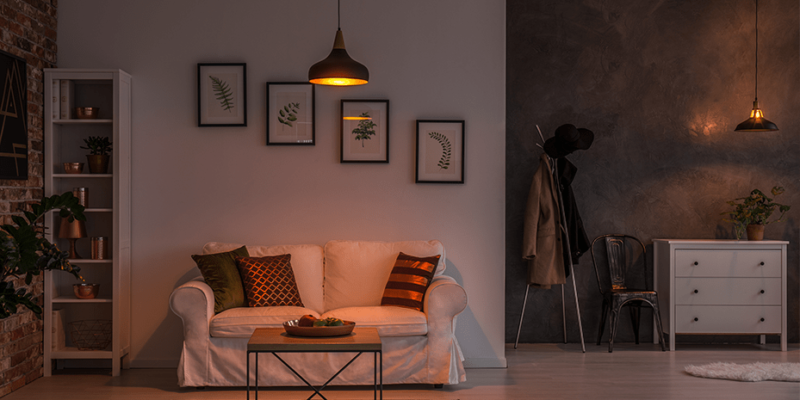Your Complete Guide to LED Dimming, Dimmers and Dimmable Light Bulbs.
Understanding the dimming process may seem challenging, which is why we’ve put together a user-friendly 4-step guide to LED dimming, dimmers and dimmable light bulbs.
Below is the rest of the article where the topic of dimmable LED light bulbs is looked at in more detail. If you still require additional help with choosing the right product for your needs, please contact our experienced customer service team by calling 01494 723 286 and we will be more than happy to help.
4 Steps to Dimmable LED’s
Dimming the lights can be one of the most satisfying things to do after a long day at work. However, there are a few factors you need to consider before choosing LED light bulbs and dimmers, follow this guide to help guarantee a smooth dimming process.

1. Check The Light Bulb
Check if the light bulb you are about to use is dimmable. Dimmable light bulbs work fine on a non-dimmable circuit; however, non-dimmable light bulbs will not work on a dimmable circuit.
You can find this information on product packaging or on our product listing pages.

2. Check Your Existing Dimmer
The type of dimmer switch and it’s minimum/maximum load range will indicate the compatibility with LED light bulbs.
There are two main types of dimmers: “Trailing Edge” and “Leading Edge”
Trailing edge dimmers work best with LED light bulbs and leading-edge dimmers work best with traditional incandescent and halogen light bulbs.

3. Do The Maths
To find out how many LED light bulbs your dimmer switch can support, divide the minimum and maximum load of the dimmer by 10.
For example:
Dimmer is rated 100W-400W
Dimmer Min Load: 100W / 10 = 10W
Dimmer Max Load: 400W / 10 = 40W
This means that when this dimmer is used in conjunction with LED light bulbs, the load must be between 10W – 40W.
Then, add up the combined wattages of the LED light bulbs to find out how many can be supported by this dimmer.
Note: The total wattage of the LED light bulbs on the circuit MUST exceed that of the calculated minimum load of your dimmer.
Using an LED load outside of this range could cause flickering or poor dimming performance and could lead to an early failure of the LED light bulbs.

4. We Are Here to Help
Our team have extensive experience with dimmer switches and LED lighting.
For more information, call our friendly and knowledgeable customer service team and we will be happy to assist.
I’m not a betting man, but if I was asked to wager why most people choose dimmable light bulbs over their standard counterparts, I’d probably go with their aesthetic potential.
By manipulating a tiny knob on one’s living room wall, it’s possible to completely alter the mood and ambience of a room at the drop of a hat. However, this actually carries with it a host of less obvious but equally favourable benefits such as reduced energy consumption and improved longevity – the longer your light bulbs are dimmed, the less energy they use and the longer they last. Got it? Great.
The proliferation of LED light bulbs in recent years has magnified these benefits yet further, with massively reduced wattages and hugely inflated lifetimes meaning that our light bulbs are now lasting longer than ever before.
But (there’s always a but), the advent of LED has also completely changed the dimmer game. Dimming your traditional incandescent light bulbs is still fairly straightforward, as I’ll explain below, but dimming LED light bulbs is somewhat trickier.
This dimming for dummies guide aims to address each of the whys and wherefores from the wonderful world of dimming, and it’s my hope that you’ll emerge on the other side a bonafide dimming dynamo.
Before we dive headfirst into our dimming odyssey though, we’ve included a FAQ of questions below.
In a word, no.
Dimmable LED light bulbs and their non-dimmable counterparts use entirely different componentry, so putting a non-dimmable light bulb on a dimmable circuit and expecting it to work is a bit like chucking a toaster into the sea and expecting it to swim – it’s only going to end in a crushing disappointment and some seriously damaged electrics.
This isn’t true of the reverse though; a dimmable light bulb will work just fine on a non-dimmable circuit, it just won’t dim. But hey, at least your electrics won’t have been blown to pieces.
This would entirely depend on the type of dimmer you have. If you’ve been using your dimmer with incandescent or halogen light bulbs in the past, I’d wager (not a betting man, remember) that it’s a leading-edge dimmer, though this may not always be the case. This assumption is based on the idea that leading-edge dimmers have been around much longer and are therefore more ubiquitous than the newer trailing edge variant. In this instance, it’s best to check what kind of dimmer switch you have.
Okay, so there are numerous types of dimmer switch available, but by far the most popular are the two that we’ll be concentrating on today – leading edge and trailing edge phase-cut dimmers.
As their name implies, both work by trimming the voltage at various phases of an alternating current’s sine wave, thereby reducing the power they send to the lamp. Now, at this juncture, I’m aware that there’ll be some amongst you that are itching to know exactly how this works, which is why I’ve kindly included a our leading edge and trailing edge dimmer guide here. You’re welcome.
For those of you that are still with us, it’s best to think of things as simply as this…
• Leading-edge dimmers are by the far the more popular of the two. They’ve been around much longer and are traditionally used to dim traditional incandescent and mains halogen light bulbs. This lends them a much higher wattage range (normally anywhere between 250W and 1000W) making them less likely to work with LED light bulbs, though this can be possible if the required tolerances are met.
• Trailing edge or LED ready dimmers have been designed specifically for use with LED light bulbs. As such, they share a number of characteristics that make them much more compatible, such as comparable wattage ranges and inherently digital makeup. The required wattages for these dimmers are much lower, making them more compatible with the lower wattage of LED light bulbs. Again though, trailing edge dimmers CAN also be used to dim traditional incandescent light bulbs if the wattage tolerances are still met, and they do this more effectively than using a leading-edge dimmer to dim LED light bulbs.
The best way to avoid confusion here is to check which dimmers are compatible with a certain type of light bulb. Most manufacturers rigorously test their products for compatibility with a range of dimmer switches and the results are normally readily available on their respective websites.
Dimming traditional incandescent light bulbs is relatively straightforward. Any leading edge dimmer carries with it a minimum and maximum load. As long as the light bulb or light bulbs paired with the dimmer sit within these tolerances, everything will work just fine.
The most common modules available generally limit their loads to 250W, 400W, 600W and 1000W at the top end and 25W, 40W, 100W and 150W at the bottom respectively. So, by way of example, if you use 4 x 100W incandescent light bulbs on the 400W module it’ll work just fine, but if you try a single 100W light bulb on the 1000W variant it would exhibit a number of problems, from flickering and excess noise to outright failure.
The mistake that many people make is assuming that trailing edge dimmers work in the same way as their leading-edge equivalents. This is a mistake – they are more expensive, infinitely more complex and absolutely brilliant when used properly.
They use a complicated, albeit sophisticated electronic system that yields a whole slew of benefits from silent operation to smoother control. They also generally have a lower minimum load than leading-edge dimmers, which is why they’re better suited to the more modest wattages associated with LED light bulbs.
How many LED light bulbs can I use on my dimmer?
One of the biggest problems people experience when installing trailing edge dimmer systems is working out just how many LED light bulbs it will support.
The main root of this problem is the massive disparity between incandescent and LED wattages. When a dimmer’s rated wattage is defined, it doesn’t take account of an LED light bulb’s drastically superior efficiency.
So, imagine we have a 400W trailing edge dimmer. It will accept 4 x 100W incandescent light bulbs without any issue and you can dim them to your heart’s content.
However, this doesn’t mean that you can then go and stuff 40 x 10W LED light bulbs on there and still make up the 400W. Oh no. This isn’t Disneyland. I’m afraid you’ll need to divide the dimmer’s maximum wattage by 10 to get its relevant value for LED light bulbs.
In this instance, it would be able to take 4 x 10W LED light bulbs or less, providing that the minimum wattage is still met.
However, it’s important to stress that this logic purely serves as a rule of thumb and is by no means exact. This is one of the myriad reasons why full compatibility cannot be guaranteed, which leads me neatly on to my next and final point…
You’re under-loading your dimmer!
This is a fairly common problem when people remove their old incandescent light bulbs and simply replace them with LED equivalents. Imagine you have two 60W filament light bulbs paired with a leading-edge dimmer that has a minimum load of 25W and a maximum load of 250W. In theory, this set up should work perfectly: the combined wattage of the light bulbs equals 120W, which is well above the dimmer’s minimum requirement but also well below its maximum. Now imagine that you decide you want to improve the efficiency of your home and invest in some sexy new LED light bulbs. These clock in at just 6W apiece and will absolutely eviscerate your lighting bill – result. Unfortunately, though their combined wattage of 12W gets nowhere near the 25W minimum and so they’ll most likely flicker, fail or blow your electrics. So what’s the solution? A low wattage trailing edge dimmer of course!
You’re over-loading your dimmer!
This is probably the most common mistake that people make when switching to LED, whereby they forget to divide the dimmer’s maximum wattage by 10 when considering its tolerances for LED. Remember to do this before assessing where your light bulb sits in terms of its wattage. If you’ve divided the dimmer’s rated wattage by 10 and your LED light bulb(s) cumulative wattage sits between its maximum and minimum values, crack on.
Plain bad luck.
Sometimes, you do all you can and the world still just wants to watch you struggle. You see, the virtue of LED light bulbs is that they don’t run on mains voltage alternating current, they instead use low voltage direct current. This bestows a number of their most laudable benefits, but it also means they require an electronic driver to convert the voltage they receive from the mains. These are built into the light bulb itself (which is why you can retrofit LED Lightbulbs Directly to existing fixtures without having to rewire them) but they need to be compatible with a dimmer’s components to dim properly. If they’re not, they won’t, and unfortunately, this isn’t something you have much control over – it all comes down to the manufacturer. This is why most manufacturers will normally provide a list of compatible dimmer switches that have been tried, tested and certified for use with their LED light bulbs.
Make sure your LED light bulbs are dimmable.
This is by far the easiest bit. A basic ability to read the light bulb’s packaging and product description should set you right here.
Upgrade your dimming circuit from leading edge to LED-ready trailing edge.
Leading-edge circuits CAN work with LED technology, but it’s much trickier to fathom, presents much more of a risk and won’t do wonders for the longevity of your light bulbs.
Use a compatible dimmer.
For the most part, we would recommend our Varilight range of dimmer switches. They’re compatible with an extensive number of LED light bulbs and carry very accommodating tolerances, from low minimum loads to generous maximum capacities.
Move to a non-dimmable circuit.
How much do you actually use your light bulb’s dimming function? Once a year at Christmas when the family’s round probably isn’t enough to justify the additional headache. The easiest and most efficient way to remove any potential set of issues is to simply remove the environment in which they’re allowed to arise.
Ensure that all your light bulbs are of the same type and from the same manufacturer.
This ensures that all the drivers in the circuit are made by the same people and therefore remain mutually compatible throughout. If you use a smattering of Philips light bulbs that are compatible with a particular dimmer but then intersperse them with light bulbs from another brand, you’re going to compromise your circuit as a whole.
Replace low voltage light bulbs with mains voltage versions.
This removes the need for external transformers and minimises the risk of compatibility issues here also. As above, if ALL of your light bulbs are made by Philips but require a third-party transformer to convert their voltage, it also needs to be compatible. If it isn’t… you get the picture.
Dimming LED light bulbs CAN certainly be tricky, but when done properly the benefits are endless, from the improved efficiency and longevity of the light bulbs to smooth, silent dimming that looks infinitely better than its incandescent equivalent.
Just one final note: even though you don’t need to be an electrician to understand why or how certain types of circuit work, we would always advise enlisting their help when actually doing any kind of work on them.





Hi , what wattage trailing edge dimmer module would i use when converting 19 halogen down lighter bulbs to led bulbs
I bought a Bankers Lamp that requires either a T30 or T45 60watt bulb. Unfortunately, all I can find, regardless of how much I search, every single one comes up Dimmable. And I understand completely that Dimmable bulbs can be used in any fixture,
BUT I cannot find any answer when a Dimmable bulb is turned on whether or not it is fully Lit or dimmed. If it is at full power that is fine, but if it is dimmed already after turning on, then that wouldn’t work for me.
It will turn on at 100% full brightness, the dimming technology is driven by the power source, not the light bulb. So if the bulb receives full 240V 50hz power it will light at 100%
hey yall seasons greetings out there
‘ broadest dimmable range ‘
is there a specific term that defines ‘broadest dimmable range’ in the world of dimmable light bulbs ?
in other words you can adjust the rage from very-low-dim to full-blast on the best bulbs. medium bright to full-blast on the crappiest brands
so what specification? should i be looking when I want bulbs that have the ‘broadest dimmable range ‘ ??
so far no one on the planet can answer this 🙂
Typically, a good quality dimmable light bulb can dim between 10% to 100% full brightness. But this very much depends on the dimmer switch. Manufacturers of dimmable light bulbs often release dimmer switch compatibility results on their website and they often will state that so-and-so dimmer can work with X number of bulbs, and dim to 20% for example.
I bought a new panel LED light for my kitchen. It says I can switch between the 3 different temperatures 3k, 4k, and 5k using an integrated light switch. Does this mean a dimmer switch or something else? I installed a dimmer switch and the light does dim but is that really changing the temperature?
An integrated switch would mean a switch actually on the panel itself, as in integrated into the fitting. You will probably find it on the reverse of the panel.
Can I dim a string of 50 x 2w s14 led festival lights? If so , how?
In theory yes, BUT dimming 50 light bubs is quite a challenge and you would need a very professional grade dimmer and very high quality bulbs to do that.
We have bedside lights operated by touch with three levels of light. Halogen candle bulbs work with them but the light differential is reduced to bright, almost as bright and not quite as bright unlike the three very different levels with old-fashioned bulbs. Is there a solution to this problem please?
I have an old decorative light fixture in a 100 year old home. Not sure if it’s original, but it’s old. Can I put a dimmable LED in it if I get a trailing-edge dimming switch? Thanks!
Theoretically, the age and type of fitting shouldn’t matter – so long as it is wired safely and correctly.
Hi Guys
I have a dual switch Legrand leading edge dimmers installation supporting 7x halogen downlights. The installation was done 27 years ago. Recently, immediately after load shedding, I switch on the lights but they don’t come on (both switches), after about one hour I can put on the lights. Also, after being able to turn on the lights, some may flicker for 30 minutes. I switch them off and on and they turn on without the flicker. Would you suggest that I replace the dimmers?
Many thanks
I would suggest this yes.
Hi There, can you solve this one please? Just been decorating the hall stairs and landing and have renewed the old candescent 2gang/2way dimmer for a 5/150w trailing edge switch. We have put a 6w LED (as fitting says max 7w) in the light and it flickers as soon as its switch on. We thought we had done everything correctly as we looked into what was needed to upgrade to LED. I have found that the old dimmer controls work ok when i connect them back in, no flickering, but there is a small but noticeable drop in luminosity, the LED dimmer does make the buld a bit brighter. What have i done wrong?
John
Not entirely sure, but the flickering is normally a symptom of a dimmer switch that is incompatible with LED light bulbs.
Hi ive just bought a center light fitting which says it’s non dimmable but I didn’t realise that the light switch is dimmmable can I still use the light fitting if i dont try to dim it ? It has 6 bulbs and says it can support 7W in each
Even if the dimmer is turned to 100%, it still may be actually affecting the phase of the electricity which could cause problems to the light fitting, such as flickering. You could try it, and if there are problems, you would need to swap out the dimmer for a regular light switch.
Hi! I didn´t quite understand when I had to divide the upper limit with 10 for LEDS? If I buy an ABB Basic55 LED 2-400 W dimmer, do I still need to divide or this is already converted into LED?
No, in your case the driver can handle between 2W and 400W, so a low wattage LED bulb is fine (as long at is 2W or higher)
Just trying to understand the math in the discussion around
Why are my LED light bulbs flickering or not dimming correctly?
The wattage range listed for the leading-edge dimmer is 25W – 250W. For LED bulbs I understand we are to divide this by 10 to obtain the operating range. This would be 2.5W to 25W, for which 12W should be fine in the example. Does the ‘divide by 10’ rule apply to the ranges listed for both leading-edge and trailing-edge dimmers?
Hi. I would like to install some wall lamps and the idea is… when I get into the house to turn on all the wall lamps by a normal switch. But therefore on those lamps I want to install two different dimmers so I can dimm lamps as I want to. But for example when I go to sleep I am gonna turn of the lamps by the dimmer, and when I leave home in the morning I will turn off the switch which is installed on the hall. So my question is, is there any method that when I come back home and when I press the switch, all the lights gonna be on, meanwhile the dimmer is on off mode? Is there any dimmer that can function like this?
I really need help!
Best regards: Agron
Hi, you can certainly put a dimmer and a normal switch on the same circuit, but you cannot put two dimmers on the same circuit. Have you considered using dimmable smart bulbs as they allow for a lot of functionality and can be grouped together to dim together or independently.
Can I ask – is the dimming only a matter of having suitable dimmer switch and dimmable light bulb (in my case, I want LED)? Or does it also depend on other factors – such as the design of lamp / wall light itself? The reason I ask is that I was going to buy a ceiling light which is to be fitted with G9 light bulbs (which are not included) and was told by the seller that the ceiling light itself is NOT dimmable (despite me saying I was going to put dimmable LED light bulbs in it). Is that right? Are there lamps / lights that might make the system non-dimmable, even if both the switches and bulbs are dimmable?
In the case of a G9 light bulb, since this is a 240V mains operated bulb, then there should be no other component in the fitting that interferes with the dimming operation i.e. the bulb should be directly wired to mains.
hi a friend of mine replaced a lamp on his reading light with an osram lamp from robert dyas but it did not work. He asked me to take a look. I swapped it out for bogs standard ses led lamp. Problem solved I told him to take the lamp back for a refund. The shop told him it was a dimmable led and would not work without a dimmer switch they demonstrated it in the store and gave him a non dimmable version of the lamp. I have been sparking a long time but have never come across this before.
sorry if i am posting in the wrong place but I just wanted to get this out.
Just for the record – Dimmable LED lamps work perfectly well on normal on/off light switches.
Hi,
I installed a Ruiwing light fixture in my living room. Which dimmer light switch is great for this light fixture?
Hi Carlos, not something we could answer – you will need to contact the manufacturers.
Hi,
I replaced all the 60watt incandescent flood light bulbs (in cans) in my basement with “soft white” LED bulbs. I am using the original dimmer switch. The lights are really too bright, but when I dim them they cast a very blueish cast in the room. This very unpleasant. This makes the room look very sterile and basement-like.
Can you tell we what is going on here?
Is this a common problem?
I will probably change to 2700 or 3000K bulbs so the light is warmer a full brightness, but I am concerned they too will turn blue when dimming. And, change to an LED capable dimmer.
Will this solve the problem?
Can you recommend a solution?
Thanks,
Tom
That sounds rather strange, what manufacturer/model bulbs are you using? I cannot imagine any scenario where the bulb would change colour as you describe unless designed specifically to do so (and when this function is designed into a bulb, it is to make the bulb even warmer when dimmed). I feel there is some malfunction in play here with the bulbs.
Hi this is a really helpful site
I have a question I have 3 x dimmerble
4 watt screw lamps my costumer supplied the dimmer the range on the dimmer was 05-150 watts the dimmer doesn’t work the lamps just flashed
what dimmer would do the job help 👍
Firstly, confirm that the light bulbs are indeed of the dimmable variety – then check out range of LED compatible dimmers available in a range of styles and options.
Great article! I have some under-cabinet halogen lights in the kitchen which have suddenly stopped working. Could this be because of the transformer or switch? They are controlled by a dual dimmer switch, which also controls the main light in the centre of the kitchen, which is a Philips smart LED bulb. I’m not sure whether it is a leading or trailing edge dimmer. What type should it be if it’s controlling both Halogen and LED lights?
Surely the Philips smart led bulb does not require a dimmer to work as this would be controlled via voice or your smart phone? Either way, dual dimmer switches should have two independent dimmer modules inside, and if those modules are similar to our Varilight range of dimmer switches, then each module can be programmed for either halogen or LED.
Hi guys
I am looking to add a 2 gang dimmer to my kitchen diner, there are two banks of lights , 6 in the first bank and 4 in the 2nd . Each downlight is 36v 8watt and are dimmable .
What rating of Dimmer is best suited to this task pls?
Hi Neill, our Varilight V-Pro 2-gang dimmers are compatible with a range of circuits due to their ability to switch between leading/trailing edge modes. They also support low voltage electronic transformers. As your fittings are 36V, I would recommend you first try to identify the transformer used to ensure it is of the electronic type (rather than wire-wound). You can read more about this type of dimmer switch on the Varilight website – good information is in their PDF instructions.
I have a PDL 520 rotary dimmer 40w min 400wmax will this work on 40w incandescent bulb ?
Yes, that will work fine.
If I purchase an led light fitting which has comes with a remote control to dim the light do I also need a dimmer on the wall switch or will the conventional on/off switch be unaffected Ted y the remote
If it comes with an remote control, then no, you probably don’t need a wall dimmer switch, the dimming components will be built into the fitting.
I have a chandelier with 30 g9 halogen bulbs, I replaced the bulbs with 30 3w g9 LED, replaced the dimmable switch to a Lutron 3 way LED rated switch with max 600w. The fixture smell electrical hot. 🤷♂️
Are the LED G9’s dimmable?
I have dimmable led bulbs…and a standard dimmer switch…will they be able to be dimmed?
Hi Betty, it all depends on the dimmer module in the dimmer switch and whether it is LED compatible. The only way to find out is to simply try the bulb on the dimmer circuit. We stock a wide range of LED compatible dimmers if you find your dimmer switch doesn’t work properly.
I’m in the US. I have a 120v chandelier that uses g4 bulbs. The chandelier is controlled from two locations. I want each location to control dimming. The seller has told me that this fixture is dimmable. I have purchased 2 sets of dimmable lights. An electrician has tried using Lutron Maestro and Maestro Pro dimmers. Nothing works. Any suggestions for a dimmer that would work?
Sorry we are not familiar enough with US 120V light bulbs to suggest an answer.
We have just put new light fittings up and now nothing works. The lights have a dimmer switch and the new fittings have bulbs that are LEDs. Could this be the cause of the failure of the lights in this room?
Are the LED’s rated as dimmable? Even if they are not, I would expect at least some kind of activity when turned on; which leads me to think the fitting may be wired wrong, or there is another issue with the switch or wiring circuit. You could also try replacing one of the lightbulbs with an older technology that you know is a good working light bulb, then remove the other LED’s. If the light fitting still doesn’t light the old light bulb then this would definitely point to a wiring issue.
Hi, thanks for a lot of information here. I have two questions. First, is ok to mix brands/wattage on a dimmable circuit? e.g. I have a room that has four lights but only one light has blow that I want to replace.
Second is, when I was in the store I noticed some dimmable replacement lights had “master” on them. I was not sure what this meant. Does it matter?
These are for LED downlights
Yes, it is fine to mix brands on a dimmable circuit – however, you may find that different brands dim at different levels so you may not get consistent dimming across the circuit. As for ‘Master’ if this was a Philips branded bulb, ‘Master’ is a product range name and doesn’t indicate any specific extra features or technology.
I just replaced two recessed lighting bulbs (65W) with LED’s (8W) that are on the same leading edge dimmer. To my surprise, one LED is now brighter than the other across the dimming range. Is it possible that the old-style leading edge dimmer causes this phenomenon?
Are the both the same lightbulb type/manufacturer?
I have a dimmer switch but can’t dim them real low what’s my problem bulbs or switch
When we test our light bulbs with a range of different dimmer switches, we do find that some dimmer switches can dim to a lower level than others. So I would say it is the switch rather than the light bulb. If you check the bulb manufacturer’s website, you may find dimmer switch compatibility tests they have performed, and the may say what low level each dimmer can reach.
Although loading is very important when dimming LED lighting loads this is primarily important in 2 areas. Below the minimum load affects being able to fully shut the LED off and the maximum load has to take into account the surge current of the LED load when it is turned on. The X10 multiplier may be less depending on the capacitive reactance of the specific fixture. Normally Bulb flickering is a direct affect of the LED loads Power Factor. The closer the Power Factor is to “1” the less chance there is the bulb will flicker on your dimmer.
Why would the dimmer make a buzzing sound one switch line had 4 led lamps and the other switch line has 11 lamps at 4w a piece I was using trailing edge dimmers 5w-100w
Hi Harry, You should check with your dimmer manufacturer that 11 lamps is OK to use on one dimmer – even though you are under the dimmer wattage load, sometimes manufacturer’s state a number of lightbulbs that cannot be exceeded per dimmer switch.
I have a driver and 6 ft of tape light led on a dimmer and it flickers on high control
We’ve not come across LED tape that can be run from a dimmer switch (most have a built in dimmer accessed via remote) – any idea what manufacturer/model the tape is?
I have a series of eight 650 lumen LEDS that are operating properly with one dimmer. If I replace one of the LEDS with a 1600 lumen LED and dim the entire string by half, will the lumen output of the different bulbs be reduced by the same ratio?
In theory yes, dimming the dimmer to 50% should dim each bulb to 50% of it’s brightness – however in practice, different types of lightbulbs can dim at different rates.
Hi all – studying for my journeyman exam and a question concerning dimmers came up it reads: If a dimmer reduces the voltage across a 120V/100W lamp what would the voltage be at half lamps brightness? Possible answers to select from (a) 160V (b) 85V (c) 100v and (d) 120v. Anyone know the formula to calculate the voltage drop? Thanks – Lyle
Hi Lyle, I’m not a mathematician, but my thoughts are it would still be 120V – the dimmer quickly turns the current on/off, but each time it is in the on state it is still 120V.
I have 3 candle bulb wall lights. What would I have to do to make them dimmable
Looking to replace fan/light combo with fixture. I am wondering if it possible to use the switch area that housed the fan control knob to have a dimmer that can be used if the light fixture switch is turned on? Thanks!
On a 2 switch dimmer, it possible to run incadescent halogen centre light on one of the dimmer switches and then LED picture light on the other dimmer? Thanks
This should be possible, as each rotary dimmer control is it’s own independent dimmer module. However, we would advise checking with the dimmer manufacturer to find out whether the particular dimmer is both halogen and LED compatible.
I have two of the exact same dimmer switches controlling two dimmable fixtures separately. One dims, the other does not. What could be the problem?
To be fair Joe, I can’t hazard a guess as to what could be causing this – maybe you could try contacting the manufacturers customer service for guidance.
Hi – I need a dual button dimmer switch for 2 sets of LED bulbs in my living room. One set of bulbs contains 8×4.7w LED GU11 bulbs. The other set contains 5×4.7w GU11 bulbs. My current dimmer switch has broken and was causing flickering even when it did work. It used to be set up with Halogen bulbs. Please could you advise on the best switch for the job? Thanks. My current switch looks like this, so one with similar styling would be ideal.
Hi, I have 3 x Calex 8w 240v dimmable light blubs off a 250W-10 Amp Double 2 Gang 2 Way 240 V LED Light Dimmer Switch and over the past year or so the bulbs have started to flicker when I use the dimmer. We’ve tried different bulb but the issue seems to persist. Do you have any ideas? Thank you!
Hi I have a bedside light that is touch operated. It switches on at a touch very dim next touch a bit lighter then full light. The next touch switches it off. I couldn’t read the model of the bulb when it fused. Would like to replace it. Any advice please.
Hi Robert, these type of dimmer switches are notoriously bad when used with LED lightbulbs – I would suggest using a traditional incandescent or halogen lightbulb for maximum compatibility.
Thank you for providing so much information on “dimming”. Is there a buying guide for dimmable led wall light fittings?
No Berni, we don’t have any guides for those fittings. But thanks for the suggestion, we may write one soon!
Hi. What type of smart dimmers can I use with toggled linear dimmable light bulbs
Hi William, we have just launched a new product that could work nicely for you! A smart WIFI dimmer switch designed for use on dimmable lightbulbs such as dimmable LED, halogen or incandescent.
Can I have a single on/off (satellite) switch at the bedside as an ‘all-off’ before going to sleep? But at the door to the bedroom have the 2 circuits (channels) on separate dimmers?
Sorry, we can’t help with that query, please consult a qualified electrician.
Hi we have bought a light with G4 bulbs with 9 single lights. It is so so bright we bought a plug in dimmer so we could lower the light. The dimmer isn’t putting the lights low just staying the same. Could you please help. And advise what to buy for the light. Thank you for your help. Really appreciate your help. Thank You
Are the new LED G4’s LED technology? If so, it is very difficult to get the dimming driver into such a small light bulb. We advise you check with the light-bulb manufacturer on their dimming compatibility tests as they would hopefully be able to advise better.
I am hoping to add a dimmer onto a photography softbox light that has a 85W, 5500K, 110-130V, 50-60Hz bulb. Also a dimmer for a 110 by 130 volt, 50-60Hz, 45W 0.6A bulb.. Could someone tell me the type of dimmer I can use? Or is that not something that’s possible.. Thanks,
Hi i have bought a dimmer which says Tungsten Filament lamps. Single 400w dimmer (60-400w)
My ceiling lights holds 5 bulbs.
What watts should each bulb be? I bought 40w =240v will this be too much.
40×5 bulbs
Did buy dimmable bulbs
Thank you
So your dimmer is states that it is rated to work with combined total power of between 60W and 400W. If you are using 5x 40W bulbs then that equals 200W – so your dimmer should be fine.
Hi, Great info, however, ,my GU10 led bulbs just intermittent flickering even I am not using ANY dimmer ? anyway to fix this issue ( I have already changed new led bulbs from t3eh same manufacturer)
If they are not on a dimmer switch and they are definitely GU10’s then there is no technical reason we can think of that would cause flickering. That only leaves a fault in the fixture as the reason. However, are you sure they are GU10’s (the ones you push and twist to insert into the fixture)? As there is another spotlight bulb called a MR16 which looks just like a GU10, but runs off a 12V electrical supply (thus needs a 12V transformer in the fixture) – if this is the case, then it is likely that the transformer doesn’t support the low power that LED’s require. See our guide on MR16 fittings to read more on that topic
What a lovely explanatory article! Leading and trailing edge dimmers? Never heard of this one before! I’m gna go check my switches right away! But would i have to unscrew my switches from the back box to do this?
Is there an electrical danger with using a traditional trailing edge dimmer with a minimum load of 40W or 60W with an LED upgrade which doesn’t meet the minimum load requirement? Could there be overheating or sparking/arcing for instance or will it just decrease the life expectancy of the lamp. Has there been any research into this topic? Thanks